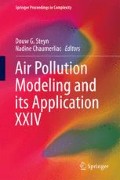Abstract
We create a streamlined approach for estimating the U.S. public health benefits of emission control, on a per-ton basis. We do so by incorporating epidemiological and economic valuation data into the adjoint of an atmospheric chemical transport model. We estimate benefits-per-ton of emission control for chronic mortality and acute morbidity endpoints. Our results indicate that benefits-per-ton of NOx reduction are highly variable from source-to-source or location-to-location. We find that mortality due to long-term exposure comprises a significant portion of the total benefits of NOx control for ozone air quality management.
Access this chapter
Tax calculation will be finalised at checkout
Purchases are for personal use only
References
Anenberg SC, Horowitz LW, Tong DQ et al (2010) An estimate of the global burden of anthropogenic ozone and fine particulate matter on premature human mortality using atmospheric modeling. Environ Health Perspect 118:1189–1195
Jerrett MJ, Burnett RT, Pope A III et al (2009) Long-term ozone exposure and mortality. N Engl J Med 360:1085–1095
U.S. Environmental Protection Agency (EPA) (2010) Guidelines for preparing economic analyses: Chap. 7—analyzing benefits, Washington, DC
Pappin AJ, Hakami A (2013a) Source attribution of health benefits from air pollution abatement in Canada and the United States: an adjoint sensitivity analysis. Environ Health Perspect 121:572–579
Pappin AJ, Hakami A (2013b) Attainment vs exposure: ozone metric responses to source-specific NOx controls using adjoint sensitivity analysis. Environ Sci Technol 47:13519–13527
Schwartz J (1995) Short term fluctuations in air pollution and hospital admissions of the elderly for respiratory disease. Thorax 50:531–538
U.S. Environmental Protection Agency (EPA) (2009) Integrated science assessment for particulate matter, Research Triangle Park, NC
U.S. Environmental Protection Agency (EPA) (2013) Integrated science assessment for ozone and related photo-chemical oxidants, Research Triangle Park, NC
Wilson AM, Wake CP, Kelly T, Salloway JC (2005) Air pollution, weather, and respiratory emergency room visits in two northern New England cities: an ecological time-series study. Environ Res 97:312–321
Author information
Authors and Affiliations
Corresponding author
Editor information
Editors and Affiliations
Questions and Answers
Questions and Answers
Questioner Name: S.T. Rao
Q: Have you looked into the costs ($/ton) associated with emission reductions needed to achieve a targeted improvement in ozone and NO2 levels and associated health benefits?
A: While we do not have detailed information about the abatement costs for NOx control, our findings suggest a significant discrepancy between costs and benefits, with benefits far exceeding current per-ton abatement costs. For example, the average NOx permit price in the CAIR emissions market in 2007 was ~$900/ton. Our findings of benefits-per-ton exceeding $50,000/ton in many places indicate significant net benefits to be gained by emissions control.
Questioner Name: Renske Timmermans
Q: Are the NOx emission reductions for specific sources? Will the effect depend on the source sectors where the emissions are reduced?
A: Our estimates of benefits-per-ton are specific to each source location (i.e., model grid cell and layer). Sector-specific information can be obtained by an emission-weighting of adjoint sensitivities. For mobile vs point sources, for example, the main difference in benefit-per-ton estimates is given by the vertical layers of emission release, which have different transport pathways and potentially different impacts on human health. For emitted species such as NOx, we find that the strongest predictor of benefits-per-ton is location rather than emission sector or source type. For primary PM, source sector would potentially play an important role in the magnitude of benefit-per-ton estimates due to its varying chemical composition and other characteristics depending on source type.
Rights and permissions
Copyright information
© 2016 Springer International Publishing Switzerland
About this paper
Cite this paper
Pappin, A., Hakami, A. (2016). Health Benefits of Emission Controls: A Multi-pollutant and Multi-health Outcome Analysis. In: Steyn, D., Chaumerliac, N. (eds) Air Pollution Modeling and its Application XXIV. Springer Proceedings in Complexity. Springer, Cham. https://doi.org/10.1007/978-3-319-24478-5_25
Download citation
DOI: https://doi.org/10.1007/978-3-319-24478-5_25
Published:
Publisher Name: Springer, Cham
Print ISBN: 978-3-319-24476-1
Online ISBN: 978-3-319-24478-5
eBook Packages: Earth and Environmental ScienceEarth and Environmental Science (R0)

